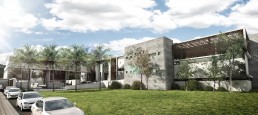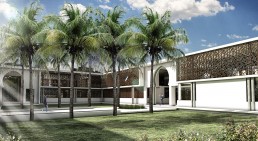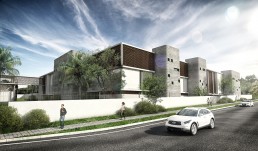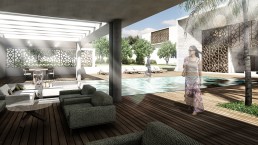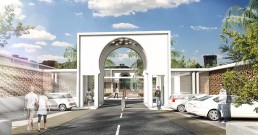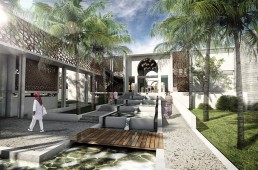The new Chancery and Embassy building for the Algerian Government located in Pretoria draws its architecture and interior references from the rich traditions of North African architecture. It uses age-old African and Persian principles such as passive ventilation and evaporative cooling, decorative shaded screening, favorable building orientation on-site, water harvesting and greywater management combined with porous surfaces to become a truly sustainable Algerian landmark.
Security and privacy was one of the main considerations in the layout and zoning of the site. Two core axis running North to South and East to West divide and connect the private and the public functions of the embassy. The public entrance is located on the Eastern side of the project and runs through the site culminating in a sculpture garden on the Western side while the North-South axis is exclusively for the use of embassy staff. Visual connection and transparency between the public and private corridors are created through the use of decorated screens.
The contemporary interpretation of traditional Algerian architectural features includes; • the use of natural materials such as concrete and timber to emulate historic mud structures and temples • the illusion of thick, solid walls as found in desert architecture is created on the south and west façades by means of slanted concrete walls • small windows which are a characteristic of North African desert architecture are incorporated into the solid wall masses. • lightweight screens that draw inspiration from historic cultural patterns • open courtyards are defined and enclosed by screens to create rich and textured sheltered spaces including water features and cultivated gardens.
The landscaping on the project continues the exploration of the cultivated, navigable garden. The East-West axis is strengthened by the use of two avenues of trees on either side, which continues from the public parking all the way to the private foyer of the Western block. The use of these tr ee-lanes clearly defines the site axis and emphasizes the main entrances. A formal garden is proposed in the central portion of the site, whilst an informal natural garden is proposed on the Westernmost portion of the site. Due to the size of this natural garden, it could also be employed as a wetland in order to filter and recycle greywater for re-use.
| Client | Algerian Government |
| Developer | Feenstra |
| Current | 2021 |
| Completion | 2024 |

